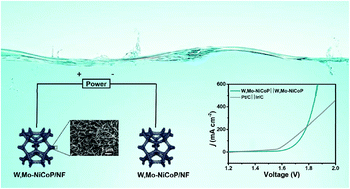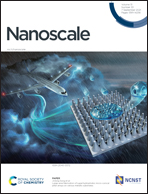Industrially promising NiCoP nanorod arrays tailored with trace W and Mo atoms for boosting large-current-density overall water splitting†
Abstract
Nanoarray catalysts supported on substrates provide an opportunity for industrially promising overall water splitting at large current densities. However, most of the present electrocatalysts show high overpotentials at a large current density, inducing a low efficiency for industrial water electrolysis. Herein, using the classic NiCoP nanorod arrays as the basic catalyst model, we presented a trace W and Mo co-doped strategy to boost the overall water splitting electrocatalysis at an industrial current density. After a trace amount of W and Mo atoms was doped, the constructed W and Mo co-doped NiCoP nanorod arrays (W,Mo-NiCoP/NF) show a low overpotential of 249 mV towards the hydrogen evolution reaction (HER) at a very large current density of 1000 mA cm−2. We deduce that the regulation of the electronic structure caused by the trace W and Mo atoms, as well as the intrinsic features of nanoarrays leads to enhanced catalytic activity. In addition, a significant enhancement towards the oxygen evolution reaction (OER) was also achieved by this co-doped strategy. Finally, an overall water splitting device using W,Mo-NiCoP/NF as both the anode and cathode was assembled to exhibit a low cell voltage of 1.85 V at a large current density of 500 mA cm−2 and an excellent long-term stability within 50 h, better than most of the state-of-the-art bifunctional electrocatalysts yet reported. Our results highlight the significance of trace-doping engineering in industrial water electrolysis.



 Please wait while we load your content...
Please wait while we load your content...